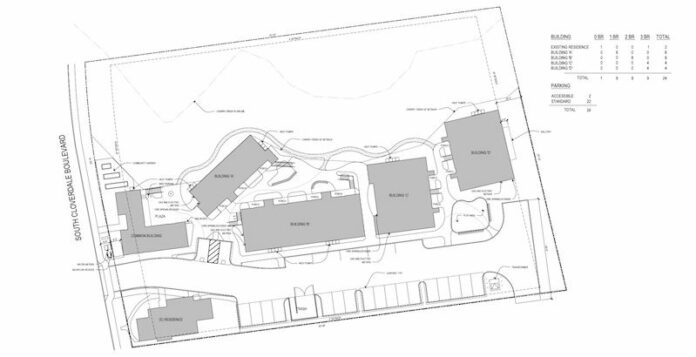Over the next couple of years, Wallace House’s Cherry Creek Village property is slated to get a facelift.
On Oct. 1, the Cloverdale Planning Commission voted 5-0 to OK a redesign for the property, which includes rehabilitation of a single-family residence and studio on the property, as well as the construction of 22 new multi-family residences.
Cherry Creek Village is operated on city property that’s designated for affordable housing use, and managed by Wallace House. Wallace House uses Cherry Creek Village for permanent, supportive or transitional housing. Some of the clients include families with children or seniors who were displaced once rent in the area began going up.
The Cloverdale City Council voted to source the affordable housing project to Wallace House in March; the nonprofit had been operating on the property already, but was facing a September lease expiration. The city is expecting Wallace House to operate and maintain the affordable housing project for 55 years.
To better accommodate the needs of the affordable housing project, Wallace House is planning on tearing out the bulk of the buildings on the property and replace them with ones that will better suit the needs of both Wallace House and its clients.
“Cherry Creek Village was originally the Ferro Motel,” said Wallace House Executive Director Colleen Holbohm, discussing the need for the land’s rehabilitation. “It was built in 1938 and was really never intended for permanent housing. The rooms are small even for single adults; they are definitely too small for families.”
Halbohm continued, saying that while the existing buildings themselves are still fairly sturdy, the lack of permanent housing design mixed with a cluster of other issues — old roofing, poor siding and “knob and tube” electrical work — point to work that needs to be done.
While the core of most of the structures are set to be rebuilt, Halbohm said that they hope to take some of the more salvageable elements of the current property, like hardwood floors, and reuse or repurpose them in the new units.
According to the description of the project, “All the current structures will be demolished except for the existing residence in the southwest corner of the site along South Cloverdale Boulevard which contains a three-bedroom residence and attached studio unit. The other 22 units would be constructed in four detached two-story buildings.”
“We will replace the nine very small inefficient studios with houses large enough to comfortably accommodate families with children,” Halbohm said. “There will also be a community building, with a kitchen and dining area for potlucks and cooking classes; offices for case management; an exercise room; spaces for recovery meetings and child care, while the parents attend meetings. The goal is to create an environment with a ‘lodge’ type feel, reminiscent of old Sonoma County, with courtyards, patios, a community garden and play areas for the children.”
When asked about planning commission discussion surrounding the project, Chairperson Michael Shanahan said that the biggest questions the commission had surrounded limited parking, but that concerns were addressed by a testimonial from Wallace House surrounding parking at the existing property.
The testimonial states that since many of Wallace House’s clients arrive with no income and those who do have income are still financially limited, it’s unlikely that they can afford to purchase, maintain and insure a vehicle. The client/unit to vehicle ratio is less than one vehicle per unit, with the amount sitting at 0.7 vehicles per unit. The testimonial states that Wallace House expects the trend to continue after the redesign.
Shanahan emphasized that the project was presented in a more thorough manner than many that the commission sees, and including things like a play area for children made the application stand out.
“I think the people that they’re working with have a really nice project,” he said. “It left little for us to deliberate back and forth on because everything was spelled out for us. It will give that neck of the woods a good facelift.”
Halbohm said that they plan to hire a relocation expert to temporarily house the people who currently live at Cherry Creek Village, and that they will return to Cherry Creek once the new houses are complete. The project is anticipated to take two years to complete.
“We are so excited to think of the possibilities to expand our programs,” Halbohm said. “This project will allow us to help more people, especially the children caught in the crossfire of addiction, who would otherwise be homeless, without this type of stability and support for their families.
62.5
F
Healdsburg
April 19, 2025








